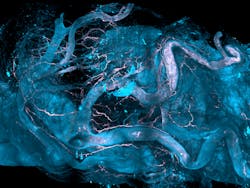Spatial-omics explores cellular organization and interactions within tissues
A spatial-omics approach developed by a team from Helmholtz Munich, Ludwig Maximilian University of Munich, and the Max Planck Institute of Biochemistry, enables the detection and molecular characterization of subtle tissue abnormalities (see video). Such pathological changes are typically very small, which makes it difficult to recognize and characterize them.
The researchers call their approach DISCO-MS, and it offers a deeper understanding of cellular organizations and interactions within tissues. It starts with DISCO (3D imaging of solvent-cleared organs) tissue clearing, which renders the mouse body or human organs transparent and more accessible to imaging. Fluorescently labelled cells can be readily identified in intact tissues of specific sites using high-resolution three-dimensional microscopy.
“DISCO-MS has the potential to disrupt how we study diseases,” says Harsharan Singh Bhatia, first author of the research who is the Spatial-Omics Team Leader at the Institute for Tissue Engineering and Regenerative Medicine (iTERM) at Helmholtz Munich. “Namely, we now can focus on the initial tiny tissue pathologies rather than fully blown pathologies affecting the whole body.”
Bring in the robots: DISCO-bot
Once the regions of interest are identified, the researchers isolate them using a new robotics technology: the DISCO-bot. The extracted tissues are processed and their proteome—the entire set of proteins expressed by a genome, cell, tissue, or organism—data is analyzed using advanced mass spectrometry (MS). This approach allows complete molecular characterization of any desired tissue region in whole mouse bodies or human organs, precisely identifying abnormal cells early in a disease.
“DISCO-MS is an unbiased technology to study tissue pathology in three dimensions from whole organs and organisms,” he says, noting that it’s unlike conventional methods, which pre-select tissue of interest and provide limited information relying only on two dimensions, in turn missing “crucial spatial information and potential molecular crosstalk of cells in a 3D space.”
As part of their study, the researchers applied DISCO-MS to an Alzheimer’s disease mouse model. Artificial intelligence (AI) was used to view the tissue samples, aiming to identify typical Alzheimer’s plaques found in the disease’s early stages. Bhatia says this has been quite difficult to detect using other techniques. The team then analyzed the proteomics of the plaques; this unbiased study of the proteins also exposed potential biomarkers for Alzheimer’s disease.
The researchers also tested the DISCO-MS system on atherosclerotic plaques in the human heart—as defined by the Mayo Clinic, atherosclerosis is the buildup of fats, cholesterol, and other substances (plaques) in and on the artery walls. This plaque can cause arteries to narrow, blocking blood flow, or burst and create blood clots.
The tissues surrounding the atherosclerotic plaques were quickly visible using DISCO-MS and AI detection. Extraction of the tissues via the DISCO-bot revealed abnormal molecular pathways in the heart cells related to plaques in the aorta, which could someday aid treatments (see figure).
“With the whole organ/organism imaging level information, we will be well informed about the whereabouts of abnormal or mutated cells at initial stages of diseases and can better select and design therapeutic options,” Bhatia says.
The researchers are now working to improve the DISCO-bot extraction system and laser capture microdissection, as well as the DISCO-MS technology, which currently presents limitations to the size of tissue that can be extracted and from which regions of an organ. The method provides molecular details on no fewer than about 60 cells, which Bhatia says is “sufficient to study plaque heterogeneity but still far from the single-cell level.”
Part of the limitations also involve the size and depth of the DISCO-bot biopsy needles, which can only look at 400 to 4000 cells at a time.
“It’s a practical issue related to the fact that smaller-sized needles have too much bend and are thus not precise enough for the job,” Bhatia says. “So, we would need some engineering solutions to extract a smaller number of cells.”
The team ultimately aims to stimulate basic research toward a more holistic way of looking at health and disease conditions. DISCO-MS can be used to study conditions including cancer metastasis on a whole mouse level, where stray cancer cells might be dispersed throughout the body. Bhatia says the robotic extraction system comes in handy to extract a single mutated cell with its microenvironment.
The team expects DISCO-MS could be used clinically by physicians interested in learning more from whole biopsies, such as 3D information on intercellular crosstalk or the volume of Aβ plaque, or proliferating glial cells in the brain.
“They would then have a better idea of which drug to administer based on the pathology and progression of the disease in question,” Bhatia says.
With the new technique, researchers’ understanding of mechanisms triggering disease formation should vastly improve.
“We will be able to identify biomarkers to develop new diagnostic tools for early detection,” Bhatia says. “And ultimately, we could develop new treatment options for tackling diseases at stages before noticeable symptoms appear.”
About the Author
Justine Murphy
Multimedia Director, Digital Infrastructure
Justine Murphy is the multimedia director for Endeavor Business Media's Digital Infrastructure Group. She is a multiple award-winning writer and editor with more 20 years of experience in newspaper publishing as well as public relations, marketing, and communications. For nearly 10 years, she has covered all facets of the optics and photonics industry as an editor, writer, web news anchor, and podcast host for an internationally reaching magazine publishing company. Her work has earned accolades from the New England Press Association as well as the SIIA/Jesse H. Neal Awards. She received a B.A. from the Massachusetts College of Liberal Arts.

